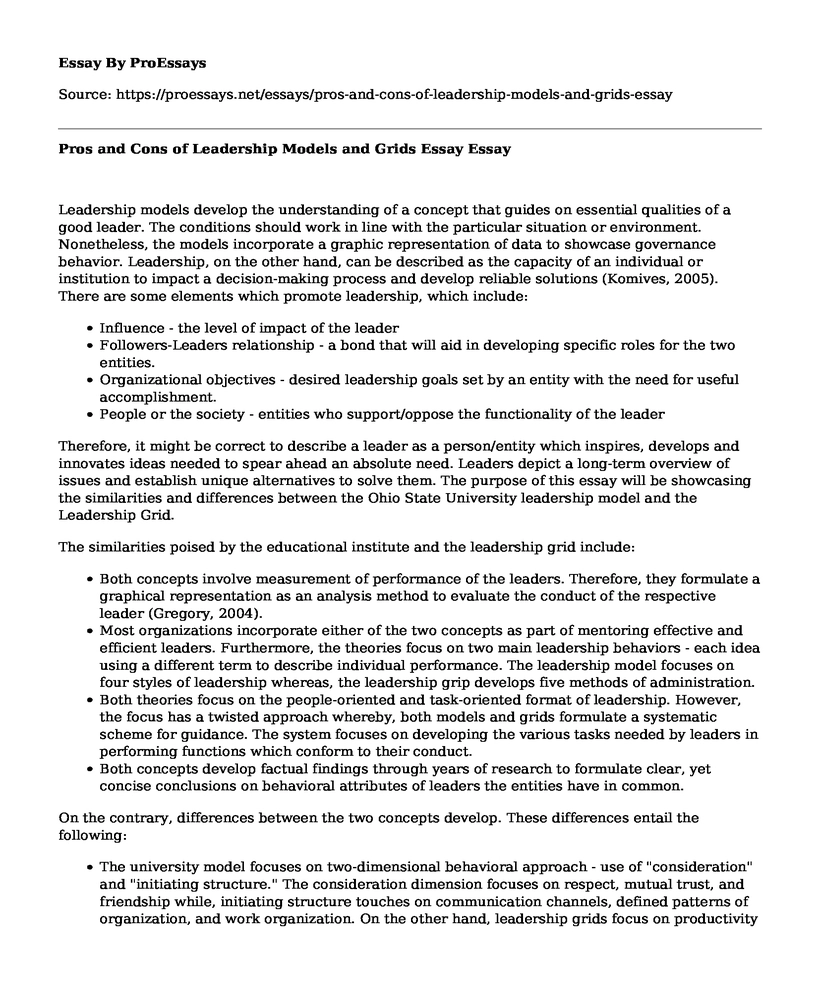Leadership models develop the understanding of a concept that guides on essential qualities of a good leader. The conditions should work in line with the particular situation or environment. Nonetheless, the models incorporate a graphic representation of data to showcase governance behavior. Leadership, on the other hand, can be described as the capacity of an individual or institution to impact a decision-making process and develop reliable solutions (Komives, 2005). There are some elements which promote leadership, which include:
- Influence - the level of impact of the leader
- Followers-Leaders relationship - a bond that will aid in developing specific roles for the two entities.
- Organizational objectives - desired leadership goals set by an entity with the need for useful accomplishment.
- People or the society - entities who support/oppose the functionality of the leader
Therefore, it might be correct to describe a leader as a person/entity which inspires, develops and innovates ideas needed to spear ahead an absolute need. Leaders depict a long-term overview of issues and establish unique alternatives to solve them. The purpose of this essay will be showcasing the similarities and differences between the Ohio State University leadership model and the Leadership Grid.
The similarities poised by the educational institute and the leadership grid include:
- Both concepts involve measurement of performance of the leaders. Therefore, they formulate a graphical representation as an analysis method to evaluate the conduct of the respective leader (Gregory, 2004).
- Most organizations incorporate either of the two concepts as part of mentoring effective and efficient leaders. Furthermore, the theories focus on two main leadership behaviors - each idea using a different term to describe individual performance. The leadership model focuses on four styles of leadership whereas, the leadership grip develops five methods of administration.
- Both theories focus on the people-oriented and task-oriented format of leadership. However, the focus has a twisted approach whereby, both models and grids formulate a systematic scheme for guidance. The system focuses on developing the various tasks needed by leaders in performing functions which conform to their conduct.
- Both concepts develop factual findings through years of research to formulate clear, yet concise conclusions on behavioral attributes of leaders the entities have in common.
On the contrary, differences between the two concepts develop. These differences entail the following:
- The university model focuses on two-dimensional behavioral approach - use of "consideration" and "initiating structure." The consideration dimension focuses on respect, mutual trust, and friendship while, initiating structure touches on communication channels, defined patterns of organization, and work organization. On the other hand, leadership grids focus on productivity and people.
- The model involves proper conduct of a leader who will appreciate the efforts of the whole team - those who participated in leadership. The model acknowledges the principles of good governance, unlike the grid which focuses on the end goal - achieving results. As much as the leadership model focuses on getting positive outcomes, team building is still highly considered. Therefore, leaders of Ohio University tend to appraise team management more than desired accomplishments.
Conclusion
In conclusion, research has stated that "team management" contains characteristics necessary for outstanding leadership. The concept encourages a leader to develop high practice concern for both people and level of productivity of an institute. Therefore, there is a need for leadership training to initiate aspect of unity amongst individuals, for example, employees at a conventional workplace. Additionally, leadership should be integrated, leaving an impact, to all pillars of society, i.e., the individual, group, or communal setting.
References
Gregory Stone, A., Russell, R. F., & Patterson, K. (2004). Transformational versus servant leadership: A difference in leader focus. Leadership & Organization Development Journal, 25(4), 349-361.
Komives, S. R., Owen, J. E., Longerbeam, S. D., Mainella, F. C., & Osteen, L. (2005). Developing a leadership identity: A grounded theory. Journal of College Student Development, 46(6), 593-611.
Cite this page
Pros and Cons of Leadership Models and Grids Essay. (2022, May 26). Retrieved from https://proessays.net/essays/pros-and-cons-of-leadership-models-and-grids-essay
If you are the original author of this essay and no longer wish to have it published on the ProEssays website, please click below to request its removal:
- Essay on Cyber Risk Management
- Management and Leadership of Virtual Teams Essay
- Essay Sample on Management Information Systems (MIS)
- My Leadership Strengths and Areas for Growth: A Reflective Essay
- Research Paper on Leadership: The Key to Lasting Success in Institutions
- Essay Example on Radburn: Unresolved Issues Affecting Teamwork and Progress
- Essay Example on Maximizing Cost Efficiency: The Benefits of Life-Cycle Cost Analysis (LCCA).







